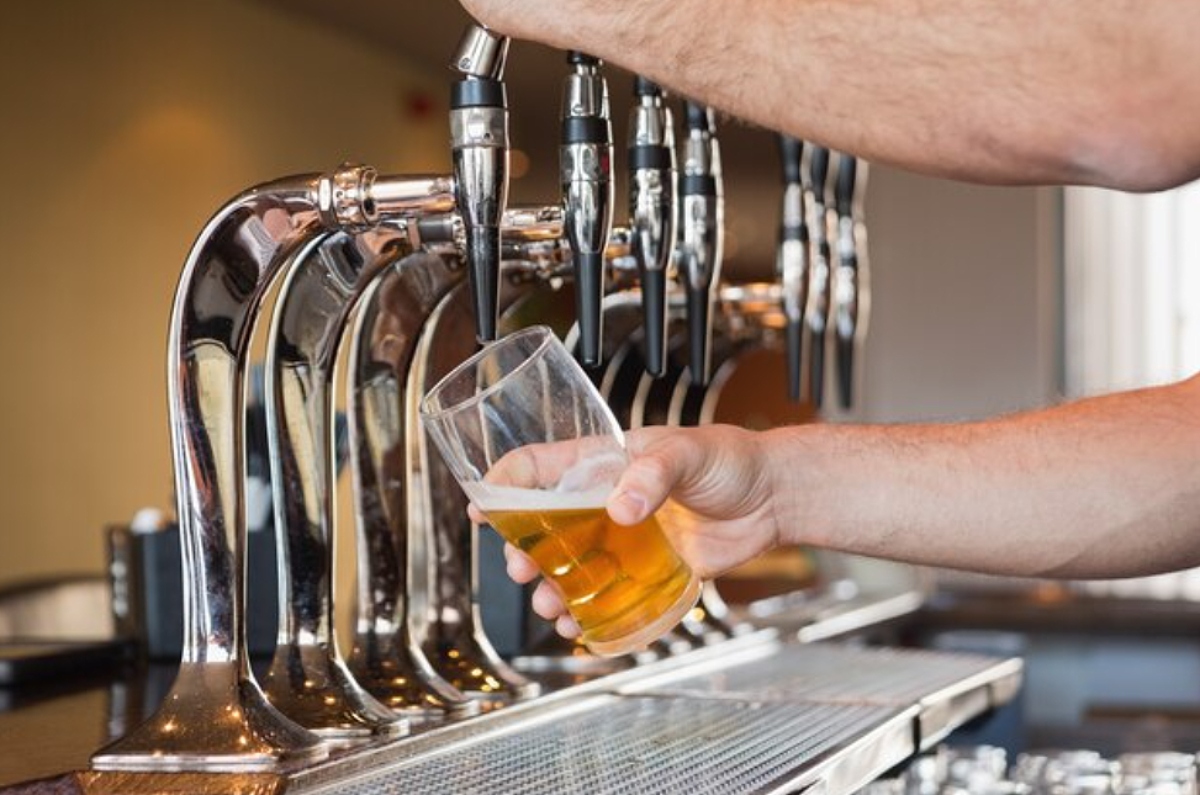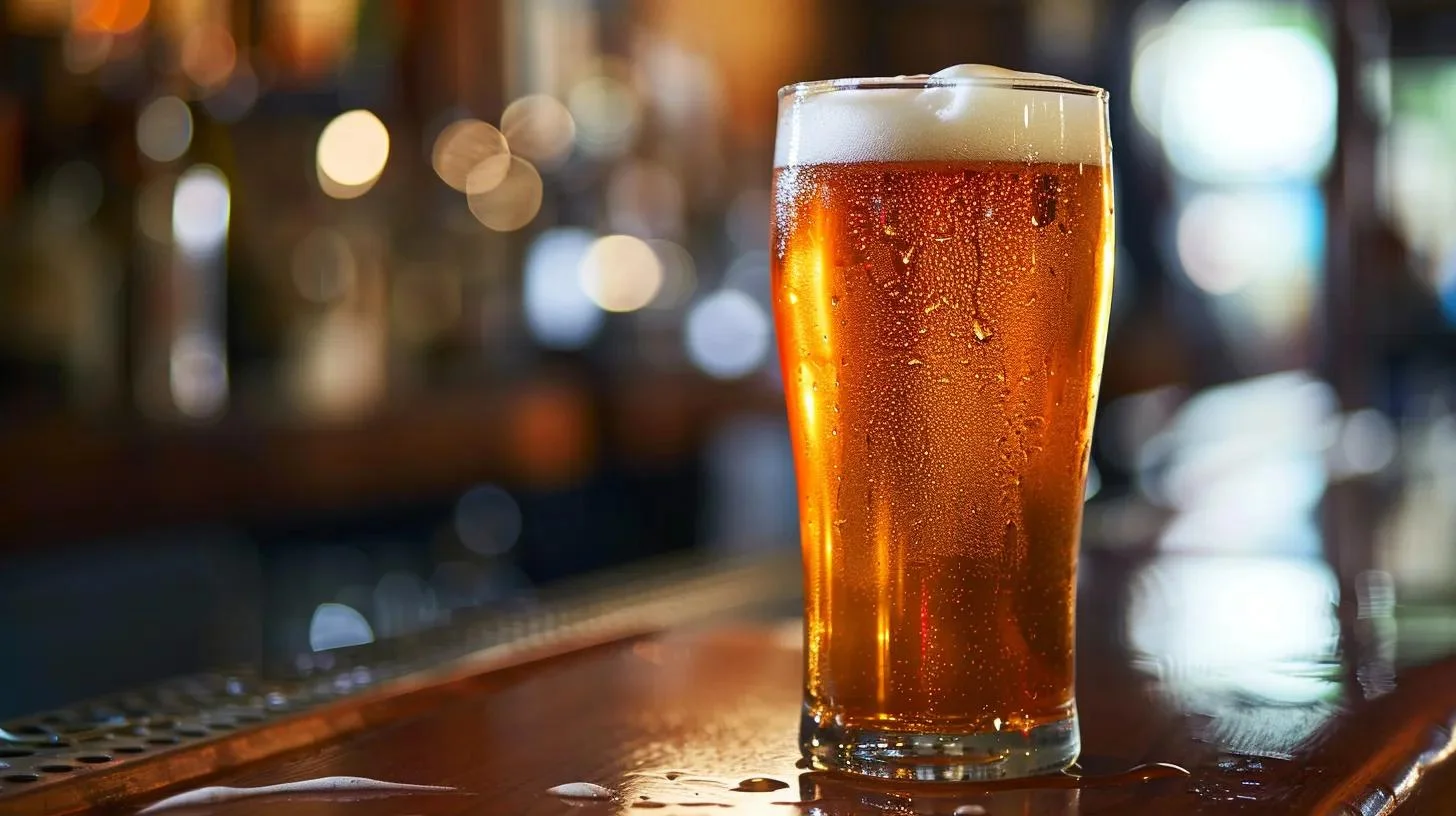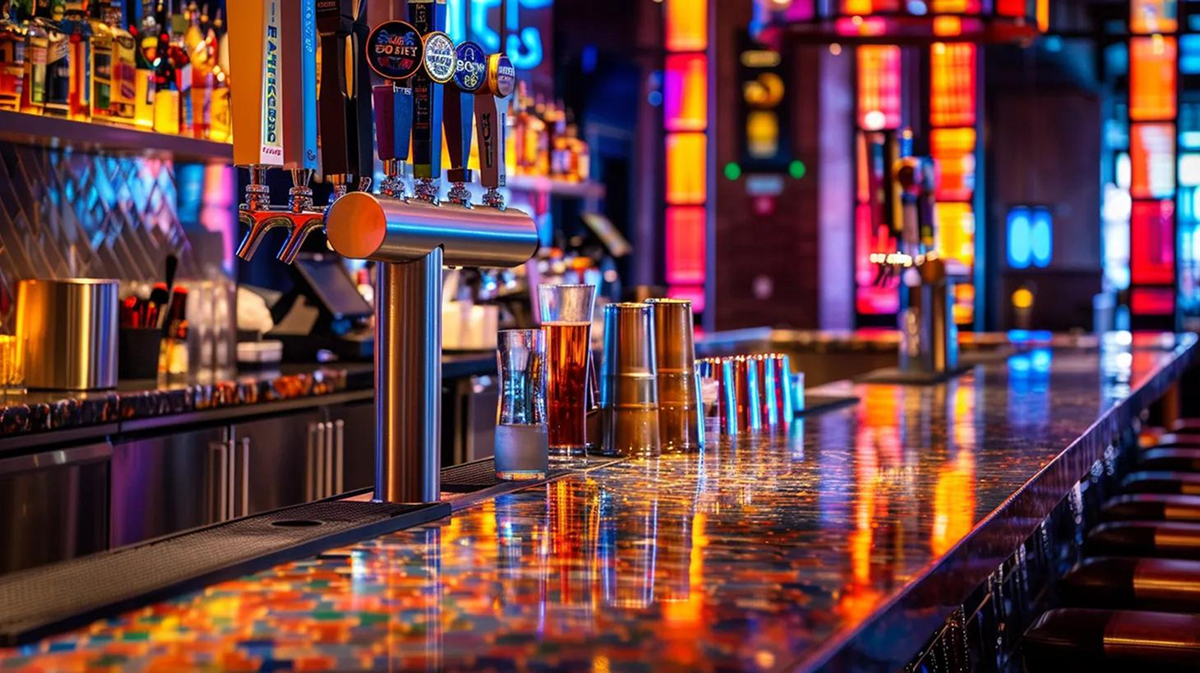Draft Beer Essentials: Choosing the Best System for Your Bar


Draught beer, also known as draught or draft beer, is a popular choice among beer aficionados and casual drinkers alike. Served from a cask or beer kegs rather than a bottle or can, draught beer often represents the freshest and most flavorful manifestation of beer, offering a diverse range of styles and tastes.
This method of serving draught beer generally tastes and has been refined since the development of the beer engine in the 18th century, which greatly enhanced the ease and quality of draught beer service.
The quality of draught beer is influenced by multiple factors including the storage temperature, the beer line cleanliness, and the gas used for pressurization.
Serving draught beer at the correct temperature is crucial for achieving the perfect balance of carbonation and flavor.
Cleanliness of the lines through which beer is served ensures the freshest taste, and the choice of carbon dioxide, nitrogen, or a mixture of both gases helps determine the beer’s mouthfeel and appearance.
- Draught beer provides a fresh and flavorful beer experience served from kegs or casks.
- Multiple factors like serving temperature, line cleanliness, and gas used for pressurization affect the quality of draught beer.
- Draught beer systems are a sophisticated technology ensuring optimal delivery from keg to glass for varied styles of beer.
The Basics of Draught Beer
Draught beer represents the epitome of beer fresh, crisp, and flavor, offering a distinct contrast to its bottled and canned counterparts. This is primarily due to its fresh dispensing method, temperature preservation, and precise carbonation.

Components of Draught Systems
Draught systems are essential in delivering the fresh taste of draft beer. Among these kegs, the corny keg, also known as the Cornelius Keg, is popular among homebrewers for its ease of use and maintenance. At the core of these systems are the kegs where the beer is stored under pressure.
Carbon dioxide or a blend of nitrogen and CO2 propels the beer from the keg through the beer lines to the tap. Consistency in temperature and pressure is key to maintaining the beer’s carbonation and flavor profile.
To illustrate, here’s a breakdown of a standard draught system’s main elements:
- Keg: A container typically made of stainless steel that holds the beer.
- CO2 or Beer Gas Cylinder: Supplies pressure to push beer from the keg.
- Regulator: Manages the gas pressure that is applied to the keg.
- Beer Line: Conduits that carry beer from the keg to the faucet.
- Draft Tower and Faucet: The point of dispense where beer is poured into glasses.
Each component works harmoniously to ensure the draft beer that reaches the consumer is as refreshing and flavorful as intended.
Keg Types and Beer Keg Sizes
Kegs come in various types and sizes, tailored to the requirements of various establishments and events. Understanding the different options helps to determine the best fit for a given setting.
Understanding the size keg is crucial for compatibility with kegerators and usage in different settings.
Common beer keg sizes can include:
- Full Keg (Standard Half Barrel): Holds about 15.5 gallons or 124 pints of beer.
- Pony Keg (Quarter Barrel): Contains roughly 7.75 gallons or 62 pints.
- Sixth Barrel: Often called “sixtels,” they hold 5.16 gallons or about 41 pints. Sixth Barrel Kegs, also known as Sixtels, are slightly larger than Cornelius Kegs and are favored for their smaller size.
- Cornelius Keg (Corny Kegs): Typically used by homebrewers, with a capacity of 5 gallons.

Each keg size serves a specific function, from the full keg’s suitability for large-scale service to mini-kegs that are perfect for small gatherings or personal use. When selecting a keg, considerations such as volume, consumption rate, and available space are paramount.
Keg Dimensions and Capacities
Keg dimensions and capacities vary depending on the type of keg, making it essential to choose the right size half keg for your bar’s needs. Here are some common keg sizes and their dimensions:
- Mini Keg: Holding 5 liters (169.07 ounces), this keg is perfect for small gatherings, offering about 14 pints of beer.
- Cornelius Keg: Popular among homebrewers, this keg has a capacity of 5 gallons (640 ounces), providing approximately 53 twelve-ounce servings.
- Sixth Barrel Keg: Also known as a “sixtel,” this keg holds 5.16 gallons (660 ounces), which equates to about 55 twelve-ounce servings.
- Quarter Barrel Keg: Often referred to as a “pony keg,” it contains 7.75 gallons (992 ounces), serving around 82 twelve-ounce servings.
- Slim Quarter Keg: Similar in capacity to the quarter barrel keg, this keg also holds 7.75 gallons (992 ounces) but has a slimmer profile, making it easier to fit in tight spaces.
- Half Barrel Keg: The standard for many bars, this keg holds 15.5 gallons (1,984 ounces), providing about 165 twelve-ounce servings.
It’s important to note that the size keg dimensions can vary depending on the manufacturer and the specific type of keg. Always check the dimensions before purchasing to ensure it will fit in your kegerator or other equipment. Understanding these keg sizes helps in planning inventory and ensuring you have the right amount of beer for your customers.
The Importance of Keg Pressure
Keg pressure is a critical component of a draft beer system, playing a vital role in both dispensing the beer and maintaining its carbonation. Proper pressure ensures that the beer flows smoothly from the keg through the lines to the tap, delivering a perfect pour every time.
If the pressure is too low, the beer may lose its carbonation, resulting in a flat and unappealing drink. Conversely, if the pressure is too high, the beer can become over-carbonated, leading to excessive foam and a wasteful pour.
The ideal keg pressure for draft beer depends on several factors, including the type of beer, the length and diameter of the beer lines, and the temperature of the keg. Generally, a pressure of around 12 PSI is suitable for many types of draft beer sizes served at approximately 38-40 degrees Fahrenheit. However, it’s essential to adjust the pressure based on specific requirements to achieve the best results.
Maintaining the correct keg pressure not only enhances the beer’s taste and texture but also ensures a consistent and enjoyable experience for craft brewers and your customers.
Serving and Enjoyment
The experience of draught beer is greatly enhanced by mastering the art of serving, which involves proper pouring techniques, understanding the influence of temperature and carbonation, and choosing the right glassware.
Perfect Pouring Techniques
To pour a draught beer with excellence, one should start by dispensing beer by holding a clean pint glass at a 45-degree angle and aim the pour to the middle of the slope, not directly at the bottom.
This method allows the beer to cascade gently, creating a smooth beer with the ideal amount of foam—about an inch thick.
As the glass fills to the halfway point, gradually tilt it upright and pour the remaining beer down the center to top off the perfect pint, ensuring a rich, creamy texture.
Serving Temperatures and Carbonation
The serving temperature and carbonation level of draught beer is pivotal to its overall enjoyment.
Each style of beer has an optimal temperature that showcases its unique flavors and aromatics.
Generally, most beers should be chilled to 36-38°F, while darker, maltier beers shine at warmer temperatures.
Properly maintained tap lines ensure that carbonation is preserved, contributing to the desired mouthfeel and preserving the beer's true character.
Glassware Selection
Selecting the right glassware is not mere presentation—it affects the sensory experience of draught, not all draft beer though.
The shape of the glass can influence the formation and retention of foam, the release of aromas, and even the beer's temperature.
For instance, a wide-mouthed glass may be ideal for aromatic beers, enhancing their scent and flavor profile.
On the other hand, a narrow, taller glass might best preserve the carbonation and temperature of a lighter, crisper beer. Glassware should always be "beer clean," free from impurities that might detract from the beer's quality.
Styles and Varieties of Draught Beer
Draught beer encompasses a diverse spectrum of flavors and brewing styles, each offering a unique experience attributed to its own beer, specific fermentation process and ingredients. The keystone to understanding its breadth lies in distinguishing the differences between ales and lagers and exploring the various noteworthy draft selections available.
Ale vs Lager Varieties
Ales are characterized by their top-fermentation process at warmer temperatures, yielding a broad flavor range from fruity and spicy to rich and robust.
Craft beers, including IPAs (India Pale Ales) and pale ales, typically fall within this category, offering a hop-centric taste.
On the other hand, lagers undergo bottom fermentation at cooler temperatures, creating a crisper and cleaner profile.
- Ale Varieties: IPA, Pale Ale, Stout, Porter
- Lager Varieties: Pilsner, Bock, Helles, Dunkel
Noteworthy Draught Selections of Craft Beers
Amidst the draught beer variety, certain beer styles stand out.
Cask ale, sometimes referred to as real ale, presents an unfiltered and traditionally conditioned form. It's revered for its complexity and natural carbonation resulting from traditional cask fermentation.
Furthermore, iconic selections like Guinness offer a distinct, creamy texture due to the use of nitrogen rather than carbon dioxide.
Unfiltered craft beers often retain more yeast and proteins than bottled beers, leading to a richer mouthfeel and flavor.
Craft beer aficionados tend to appreciate the unique qualities imparted by small-scale brewing methods and localized flavor profiles.
- Cask Ales: Unfiltered, Fermented in Cask, Naturally Carbonated
- Standouts: Guinness, Craft Beer Varieties, Miller Genuine Draft
Technical Aspects of Draught Systems
Draught systems are a symphony of engineering precision and brewing artistry. The technical aspects of these systems are critical for ensuring the quality of beer served is up to the highest standards.
Maintaining and Cleaning Systems: Keg Coupler Care
Proper maintenance and cleaning are paramount in draught systems to maintain beer quality and system longevity.
Every keg, tap, and beer engine must be routinely sanitized to prevent the buildup of microorganisms and beer stones within the tap lines. Hygiene cannot be compromised.
For instance, the Brewers Association has published guidelines indicating that tap lines should be cleaned at intervals of no more than two weeks to ensure the taste and quality of the beer remains unaltered.

Carbonation Techniques
Carbonation in draught systems can be achieved through natural carbonation or artificial carbonation.
Natural carbonation occurs within the keg as yeast ferments, while artificial carbonation involves the infusion of carbon dioxide or a blend of carbon dioxide and nitrogen gas under pressure.
The balancing of these gases is essential as it affects the beer's bubble size and overall mouthfeel. A nitrogen widget may be used in some containers like cans or bottles to create a smooth, creamy texture upon serving.
Draft Beer Quality Control and Safety
Ensuring the quality and safety of draft beer is paramount for any bar. Here are some essential tips to maintain high standards:
- Regular Cleaning and Sanitization: Clean and sanitize the draft beer system regularly to prevent contamination and spoilage. This includes the keg, lines, taps, and any other equipment that comes into contact with the beer.
- Monitor Keg Pressure: Regularly check the keg pressure to ensure it is within the recommended range. This helps maintain the beer’s carbonation and prevents issues like flat or overly foamy beer.
- Temperature Control: Keep the keg at the recommended temperature to preserve the beer’s flavor and carbonation. Most beers are best served at 36-38°F, but this can vary depending on the style.
- Use a Keg Coupler: A keg coupler connects the keg to the draft beer system, ensuring a secure and contamination-free connection. Regularly inspect and maintain the coupler to prevent leaks and contamination.
- Inspect Equipment: Regularly check the draft beer lines and other equipment for signs of wear and tear. Replace any damaged components promptly to maintain the system’s integrity and the quality of the beer.
By following these tips, you can ensure that the draft beer served to your customers is of the highest quality and safe to drink, enhancing their overall experience and satisfaction.
Business Considerations
Draft Beer Pricing Strategies
Effective pricing strategies for draft beer can significantly impact your bar’s profitability. Here are some tips to help you price your draft beer effectively:
- Calculate Cost per Draft Beer: Consider the cost of the beer, portion size, and target liquor cost to determine the appropriate price. For example, if a keg costs $100 and provides 165 twelve-ounce servings, the cost per serving is approximately $0.61. If you aim for a 25% liquor cost, the selling price should be around $2.44.
- Adjust for Market and Venue: Higher-end bars and venues may have a lower liquor cost, while fast-casual establishments and dive bars may have a higher liquor cost. Adjust your pricing strategy based on your target market and venue type.
- Price High-End Beers Aggressively: Pricing high-end beers more aggressively can boost overall profits and draft beer sales. Customers may be willing to pay a premium for unique or high-quality beers, increasing your profit margins.
Frequently Asked Questions
What is the difference between draft and draught beer?
The term 'draft' prefers traditional cask beer and 'draught' beer is used interchangeably to refer to beer that is served from a keg or cask rather than from a bottle or can.
How does draught beer differ from bottled beer?
Draught beer is typically fresher since it is served directly from a keg, which can preserve the beer's flavor and texture better than the pasteurization process that canned or bottled beers of beer often undergo.
What is the typical alcohol content in draught beer?
The alcohol content in draught beer can vary widely depending on the style, but generally falls within the same range as most bottled or canned beer varieties, anywhere from 3% to 12% ABV (alcohol by volume).
Why might someone prefer draught beer over other forms?
Some may prefer draught beer for its perceived freshness, the ritual of having it poured from a tap, and the social experience of enjoying a pint at a bar or brewery.
What are the standard serving sizes for draught beer?
Standard serving sizes for draught beer typically include the pint (16 ounces in the United States, but 20 ounces in the UK), half-pint, schooner (in Australia), and smaller tasting sizes, which might range from 4 to 8 ounces.
Summary
Draught beer, also known as traditional cask beer or draft beer, is a method of serving beverages directly from a pressurized keg or cask.
The draw of a draught beer is its freshness. It typically surpasses that of canned beer or bottled beer due to minimal exposure to light and oxygen.
Draught beer systems use carbon dioxide or a blend of nitrogen and carbon dioxide to push the beer from the keg and maintain its carbonation and unique taste profiles.
As for the benefits, draught beer is often perceived to offer a superior taste
Quality manuals and industry summits, such as those attended by the Brewers Association, highlight the commitment to excellence in serving practices and product preservation.



